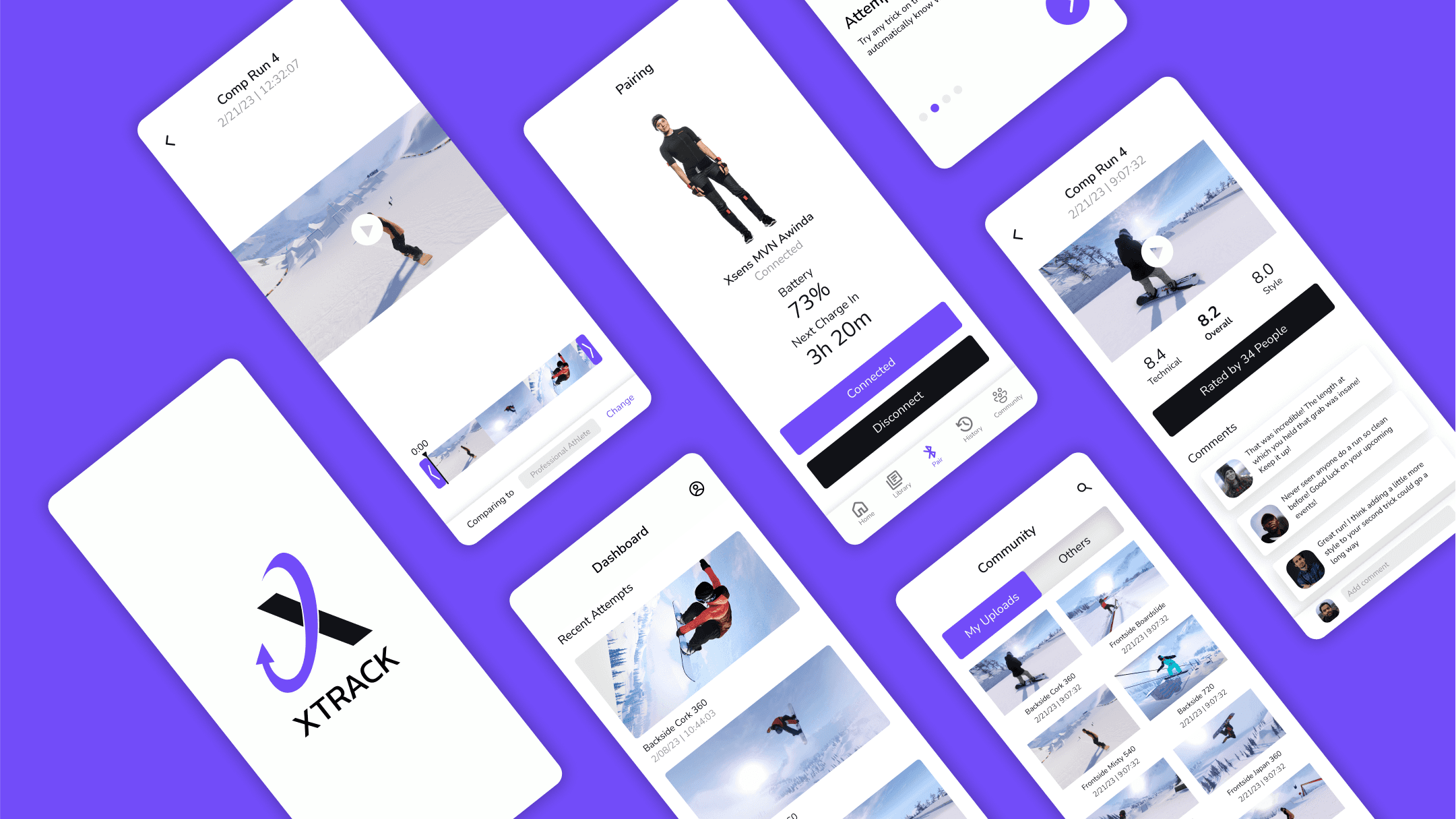
XTRACK
My Role
UX Researcher and Designer
Currently in the extreme sports industry, there are thousands of people that get injured every year. This can put athletes out of commission for weeks/months at a time, which significantly slows down their progression in the sport and places extra caution on the intensity that they can train.
How can we track extreme sports athletes' body movements to prevent risk of injury?
DESIGN
ONBOARDING EXPERIENCE
The onboarding screens are designed to guide users through the account creation process while informing them of the product's capabilities. This ensures a seamless and informative introduction to the platform.
DASHBOARD AND PROFILE
The dashboard screen showcases the user's recent activities and news updates. The profile section allows users to view their trick list, competition ratings, saved community clips, Bluetooth pairings, and personal preferences.
TRICK LIBRARY
The trick library serves as a comprehensive catalog of all known skiing and snowboarding tricks. Users can explore the list to discover new tricks they wish to attempt now or in the future.
ATTEMPT HISTORY
Users can review all their previous trick attempts in the attempt history section. This feature enables them to analyze their performances, compare attempts, and share their achievements with others.
COMMUNITY
The community tab allows users to view their competition runs and rate other users' runs for style. The software automatically assigns a technical score to each run based on the precision of the tricks performed.
UNDERSTANDING
CHALLENGES OF ATHLETES
Extreme sports are characterized by their inherent risk and the constant danger faced by athletes. Injuries are inevitable given the high stakes and the potential for mishaps. These injuries can result from various factors, including mental blocks and technical errors such as over-rotations.
Shoulder and Wrist
Most common injury site for snowboarders
Head and Neck
175,000 Injuries per year
Knee
Most common injury site for skiers
APPROACH
ASKING THE ATHLETES
To deeply understand the needs of athletes, I conducted interviews with both amateur and professional skiers and snowboarders. These conversations provided valuable insights that continually influenced my design process throughout my thesis.

Declan Kelly
Amateur Skier
“I would definitely love to be able to look at a 3D rendering, like video game style, of what the body is doing… Having the ability to slow down and look at a model where someone could explain or the software could explain what’s going on, that sounds like it could be a huge help.”

Casey Willax
Professional Snowboarder
“If you visually see what you did wrong and also what you did right… You might think you did something right but then you look at it and it is just nothing like you thought it was… Takeoff is where everything really is the most important. If you scrub just a bit too much you may not know that is why you need to take extra speed into the jump.”

Noah Bowman
Professional Skier
“The hips drive forward and that is what gets our momentum going Also, the arms and the shoulders. The direction you are throwing is what leads to the spinning. I would say the extension through the legs is a key factor in every trick.”
IDEATION
VISUAL FEEDBACK AND WEARABLE TRACKING SYSTEMS
Drawing from my interviews with extreme sports athletes, I conceptualized products that offer visual feedback. These products aim to enhance athletes' performance and safety through real-time insights.

Concept A
Selected
Visual feedback software on a mobile device could allow athletes to review their trick attempts on the mountain. Users could carefully analyze their attempt and correct their mistakes after.

Concept B
Not Selected
A newly designed smart suit with visual or haptic indicators could give users key indications of how their trick attempt went wrong and what to correct.

Concept C
Secondary
An augmented reality goggle could allow users to receive feedback on their attempts without the need for pulling out an external device. A variety of interaction methods could be tested to determine the best way to navigate through interfaces.
RESEARCH
ENHANCING THE USER FLOW
Interviews with professional athletes revealed that reviewing footage typically occurs after multiple laps on the mountain. Implementing a visual feedback software that is easily accessible to athletes can provide a more detailed analysis of their movements in a significantly shorter time frame.

TESTING
BLUETOOTH PAIRING CHANGES
User feedback indicated that the pairing screen was difficult to access and not prioritized. The pairing function is now easily accessible via an icon located in the middle of the navigation bar, significantly reducing the time required for users to pair their devices.

IMPROVED COMMUNITY NAVIGATION
The community screen has been updated to allow users to easily switch between their uploads and those of other users, enhancing the overall navigation experience.

UPDATED VIDEO PLAYBACK INTERFACE
The video playback screens have been optimized for vertical viewing, allowing users to effortlessly select and compare various attempts to assess trick accuracy.

KEY LEARNINGS
Understanding User Needs Through Empathy
Conducting in-depth interviews with skiers and snowboarders provided crucial insights into their challenges. This empathy-driven approach ensured that the final product met the athletes' specific needs.
Importance of Iterative Design
An iterative design process, with continuous testing and feedback, was key to refining XTRACK concepts. This approach resulted in intuitive solutions like the smart suit and augmented reality goggles.
Collaboration and Feedback
Engaging with athletes and incorporating their feedback ensured practical, valuable designs. This collaborative approach built trust among potential users, leading to more effective solutions.